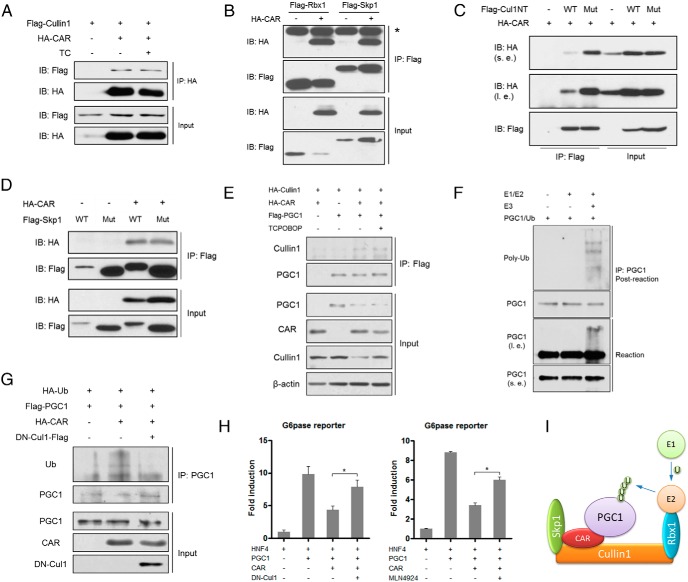Figure 5.
CAR recruits the Cullin1 E3 ligase to promote the ubiquitination of PGC1α. A, 293T cells were cotransfected with Flag-Cullin1 and HA-CAR and treated with or without TC (500nM) as indicated before being subjected to immunoprecipitation and immunoblotting. B, 293T cells were cotransfected with HA-CAR and Flag-Skp1 or Flag-Rbx1 as indicated before being subjected to immunoprecipitation and immunoblotting. The asterisk next to the top band denotes the heavy chain of IgG. C, 293T cells were cotransfected with HA-CAR and Flag-Cul1NT WT or mutant (Y46A/T47A/Y50A) as indicated before being subjected to immunoprecipitation and immunoblotting. D, 293T cells were cotransfected with HA-CAR and Flag-Skp1 WT or mutant (N108K, Y109N) as indicated before being subjected to immunoprecipitation and immunoblotting. E, 293T cells were cotransfected with HA-Cullin1, HA-CAR, and Flag-PGC1α and treated with or without TC (500nM) as indicated before being subjected to immunoprecipitation and immunoblotting. F, In vitro ubiquitination of PGC1α by CAR-containing Cullin1/SCF E3 ligase complex. CAR-containing Cullin1/SCF E3 complex was purified and mixed with purified PGC1α (see Supplemental Figure 8 for details) in the presence of E1, E2, ubiquitin, and ATP. G, 293T cells were cotransfected with HA-ubiquitin (Ub), HA-CAR, Flag-PGC1α, and DN-Cul1, followed by immunoprecipitation and immunoblotting as indicated. *, P < .05. H, Cotransfection of DN-Cul1 (left panel) or treatment with SCF inhibitor MLN4924 (right panel) abolished the inhibition of PGC1α activity by CAR in G6Pase reporter gene assay (*, P < .05). I, Proposed formation of CAR-associated E3 ligase and mechanism of CAR-mediated ubiquitination of PGC1α.

